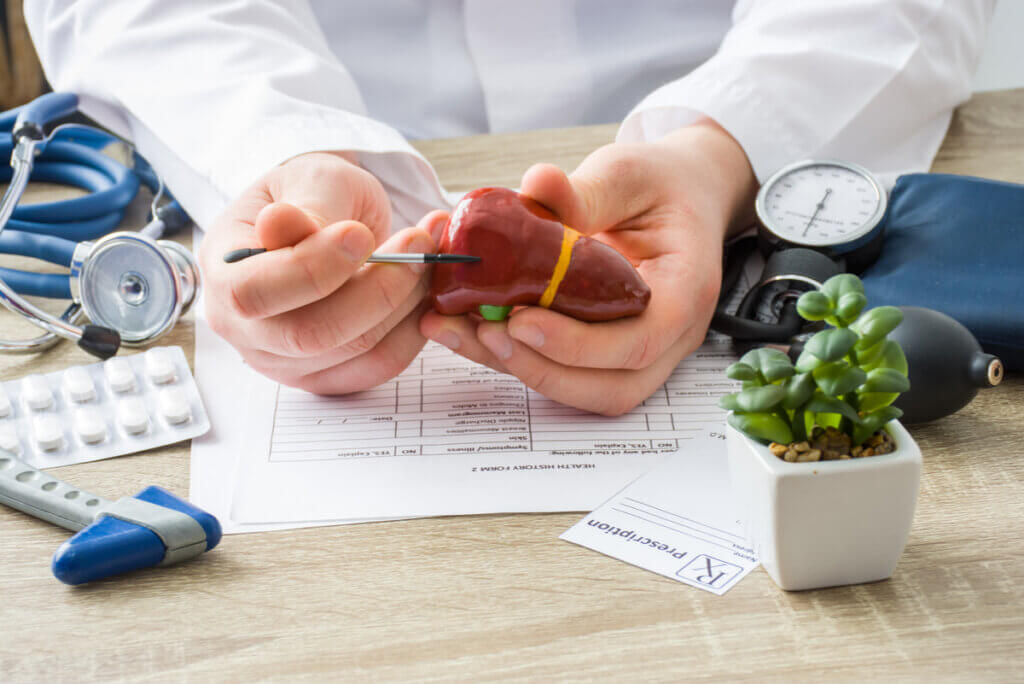Elevated Transaminases: What Do They Mean?

Transaminase levels are part of the complementary tests that make up the liver function profile. These data are very useful in the diagnosis of different diseases that can affect our bodies. Are you interested in knowing what elevated transaminases mean? Keep reading and we’ll tell you!
In most cases, elevated transaminases are a warning that something is wrong with the liver. In general, they’re associated with infectious, inflammatory, and degenerative liver processes. However, elevated levels of these substances can also lead to systemic or cardiovascular problems.
What are transaminases?
Transaminases are also called aminotransferases. They’re a group of enzymes with metabolic capacity, responsible for converting certain amino acids to others through the transfer of amino groups. They’re found in higher concentrations in liver cells.
Similarly, there are small amounts in the heart, kidneys, and muscles. Some studies affirm that the most relevant aminotransferases are aspartate aminotransferase (AST or GOT) and alanine aminotransferase (ALT or GPT). These are usually measured in laboratory blood tests.
ALT has a half-life of about 18 hours. The elevation of this enzyme is usually specific to some injury to liver cells (hepatocytes).
AST has a half-life greater than 48 hours. Its high concentration in the blood is less specific for liver damage. This is due to its presence in sites such as the brain, pancreas, lungs, white blood cells, and red blood cells.
Other enzymes that can be studied are alkaline phosphatase (FA) and gamma-glutamyl transpeptidase (GGT). Both are part of the most common types of blood tests and are very useful in the evaluation of liver and bile duct diseases.

Normal values
Under normal conditions, it’s common to find a small concentration of transaminases in the blood. The ranges usually vary according to the laboratory and the sex of the patient.
However, they’re usually within the following parameters:
- AST or GOT: 10 to 40 international units per liter (IU / L) in men and 7 to 35 international units per liter (IU / L) in women.
- ALT or GPT: 8 to 40 international units per liter (IU / L) in men and 6 to 34 international units per liter (IU / L) in women.
What do elevated transaminases mean?
Elevated transaminases are usually the result of accelerated lysis or destruction of liver cells. In this sense, the death of hepatocytes leads to the release of the components stored within them, such as AST and ALT. In this way, these substances are released into the blood vessels.
There’s a long list of diseases associated with elevated liver enzymes. However, studies suggest that there’s no clear correlation between transaminase levels and the degree of liver injury. In fact, some people may have high values and not show any type of symptoms.
In this regard, in-depth analysis of all aminotransferases and their correlation with other data is vital in order to identify the disease that is causing it. Some of the main conditions associated with high transaminases are the following:
- Nonalcoholic steatohepatitis
- Alcoholic liver disease
- Chronic hepatitis B or C
- Infectious mononucleosis and cytomegalovirus
- Cirrhosis
- Gallstones
Other possible causes
Similarly, excessive consumption of hepatotoxic drugs can lead to the elevation of these enzymes. Such is the case with paracetamol, diclofenac, statins, corticosteroids, and amiodarone. Furthermore, Wilson’s disease and hemochromatosis are also responsible for injuring hepatocytes.
On the other hand, research affirms that high transaminases can be associated with heart failure and rheumatic diseases. Other non-hepatic causes of this finding include the following:
- Myocardial infarction
- Hemolytic anemia
- Pancreatitis
- Muscle injuries
- High-intensity exercise
- Pregnancy
- Extensive burns
Treatment
Treatment of elevated transaminases is based on the identification and correction of the underlying disease. In this way, the enzyme levels will be progressively reduced to normal.
On the other hand, the doctor may indicate several lifestyle changes to obtain better results, such as the following:
- Drinking water and fluids on a regular basis
- Not drinking alcoholic beverages
- Not consuming processed foods rich in fat
- Reducing your intake of sugary and high-salt foods
- Increasing consumption of fruits and vegetables.
- Performing light to moderate exercise, 30 minutes a day, at least 3 times a week.

A sign not to be taken lightly
Elevated transaminases are a sign that usually points to the presence of some disorder or damage to the liver. The causes of this result are very extensive, ranging from intense physical exercise to cirrhosis of the liver. Routine clinical evaluation is essential for the detection of asymptomatic patients.
In the presence of elevated transaminases associated with other symptoms, it’s vital to seek medical attention as soon as possible. In most cases, an early professional approach means you can avoid complications and obtain a better quality of life.
Transaminase levels are part of the complementary tests that make up the liver function profile. These data are very useful in the diagnosis of different diseases that can affect our bodies. Are you interested in knowing what elevated transaminases mean? Keep reading and we’ll tell you!
In most cases, elevated transaminases are a warning that something is wrong with the liver. In general, they’re associated with infectious, inflammatory, and degenerative liver processes. However, elevated levels of these substances can also lead to systemic or cardiovascular problems.
What are transaminases?
Transaminases are also called aminotransferases. They’re a group of enzymes with metabolic capacity, responsible for converting certain amino acids to others through the transfer of amino groups. They’re found in higher concentrations in liver cells.
Similarly, there are small amounts in the heart, kidneys, and muscles. Some studies affirm that the most relevant aminotransferases are aspartate aminotransferase (AST or GOT) and alanine aminotransferase (ALT or GPT). These are usually measured in laboratory blood tests.
ALT has a half-life of about 18 hours. The elevation of this enzyme is usually specific to some injury to liver cells (hepatocytes).
AST has a half-life greater than 48 hours. Its high concentration in the blood is less specific for liver damage. This is due to its presence in sites such as the brain, pancreas, lungs, white blood cells, and red blood cells.
Other enzymes that can be studied are alkaline phosphatase (FA) and gamma-glutamyl transpeptidase (GGT). Both are part of the most common types of blood tests and are very useful in the evaluation of liver and bile duct diseases.

Normal values
Under normal conditions, it’s common to find a small concentration of transaminases in the blood. The ranges usually vary according to the laboratory and the sex of the patient.
However, they’re usually within the following parameters:
- AST or GOT: 10 to 40 international units per liter (IU / L) in men and 7 to 35 international units per liter (IU / L) in women.
- ALT or GPT: 8 to 40 international units per liter (IU / L) in men and 6 to 34 international units per liter (IU / L) in women.
What do elevated transaminases mean?
Elevated transaminases are usually the result of accelerated lysis or destruction of liver cells. In this sense, the death of hepatocytes leads to the release of the components stored within them, such as AST and ALT. In this way, these substances are released into the blood vessels.
There’s a long list of diseases associated with elevated liver enzymes. However, studies suggest that there’s no clear correlation between transaminase levels and the degree of liver injury. In fact, some people may have high values and not show any type of symptoms.
In this regard, in-depth analysis of all aminotransferases and their correlation with other data is vital in order to identify the disease that is causing it. Some of the main conditions associated with high transaminases are the following:
- Nonalcoholic steatohepatitis
- Alcoholic liver disease
- Chronic hepatitis B or C
- Infectious mononucleosis and cytomegalovirus
- Cirrhosis
- Gallstones
Other possible causes
Similarly, excessive consumption of hepatotoxic drugs can lead to the elevation of these enzymes. Such is the case with paracetamol, diclofenac, statins, corticosteroids, and amiodarone. Furthermore, Wilson’s disease and hemochromatosis are also responsible for injuring hepatocytes.
On the other hand, research affirms that high transaminases can be associated with heart failure and rheumatic diseases. Other non-hepatic causes of this finding include the following:
- Myocardial infarction
- Hemolytic anemia
- Pancreatitis
- Muscle injuries
- High-intensity exercise
- Pregnancy
- Extensive burns
Treatment
Treatment of elevated transaminases is based on the identification and correction of the underlying disease. In this way, the enzyme levels will be progressively reduced to normal.
On the other hand, the doctor may indicate several lifestyle changes to obtain better results, such as the following:
- Drinking water and fluids on a regular basis
- Not drinking alcoholic beverages
- Not consuming processed foods rich in fat
- Reducing your intake of sugary and high-salt foods
- Increasing consumption of fruits and vegetables.
- Performing light to moderate exercise, 30 minutes a day, at least 3 times a week.

A sign not to be taken lightly
Elevated transaminases are a sign that usually points to the presence of some disorder or damage to the liver. The causes of this result are very extensive, ranging from intense physical exercise to cirrhosis of the liver. Routine clinical evaluation is essential for the detection of asymptomatic patients.
In the presence of elevated transaminases associated with other symptoms, it’s vital to seek medical attention as soon as possible. In most cases, an early professional approach means you can avoid complications and obtain a better quality of life.
- García M, Zurita M. Transaminasas: Valoración y significación clínica. Protocolos diagnóstico-terapéuticos de Gastroenterología, Hepatología y Nutrición Pediátrica SEGHNP-AEP. 267-275.
- Cortés M. Del síntoma a la enfermedad: elevación de transaminasas. Rev Pediatr Aten Primaria. 2009 Dic ; 11(17 ): 433-436.
- García O. ¿Cómo evaluar la elevación de las enzimas hepáticas en personas aparentemente sanas?: Su importancia para el médico general. Rev. gastroenterol. Perú. 2013 Jul ; 33( 3 ): 262-264.
- Busto Bea Victoria, Herrero Quirós César. Pruebas de función hepática: B, AST, ALT, FA y GGT. Rev. esp. enferm. dig. 2015 Oct ; 107( 10 ): 648-648.
- Kelly SA, Mix S, Moody TS, Gilmore BF. Transaminases for industrial biocatalysis: novel enzyme discovery. Appl Microbiol Biotechnol. 2020 Jun;104(11):4781-4794.
- Ambrosy A, Gheorghiade M, Bubenek S, Vinereanu D, et al. The predictive value of transaminases at admission in patients hospitalized for heart failure: findings from the RO-AHFS registry. European Heart Journal. Acute Cardiovascular Care. 2013; 2(2): 99–108.
Este texto se ofrece únicamente con propósitos informativos y no reemplaza la consulta con un profesional. Ante dudas, consulta a tu especialista.







